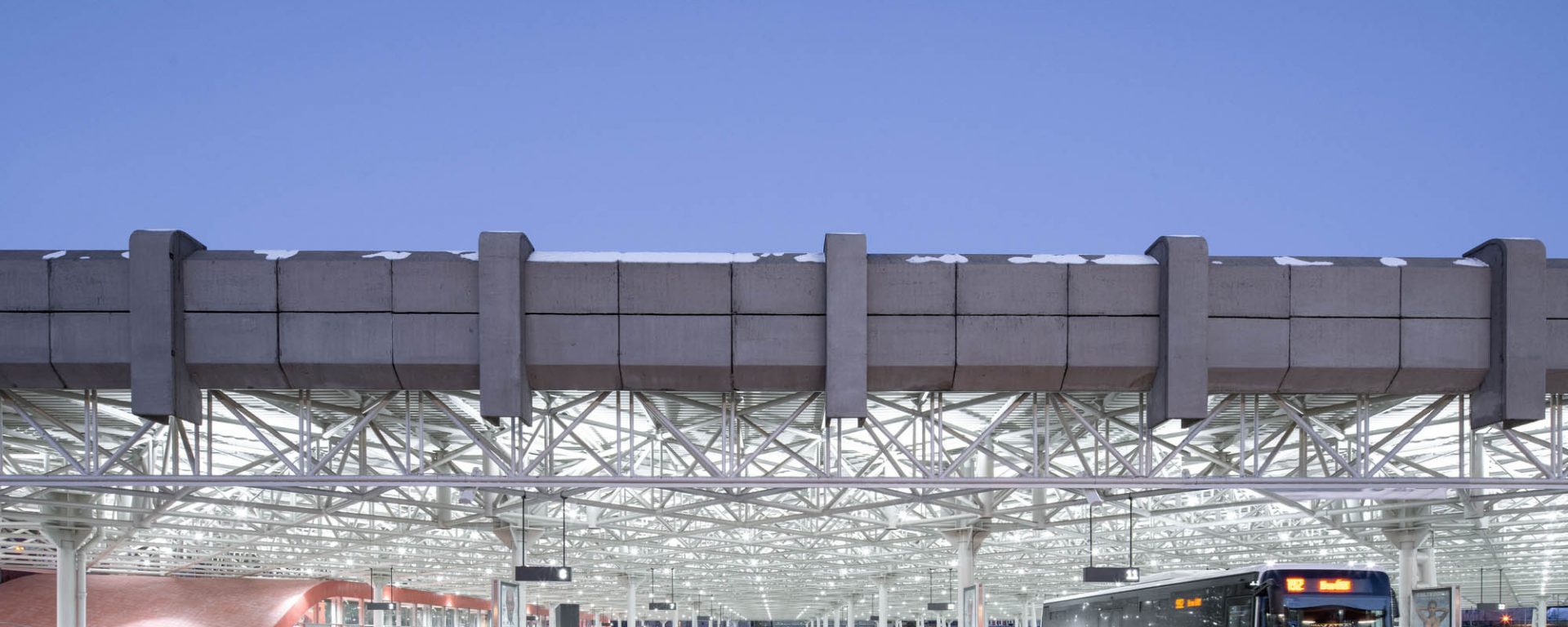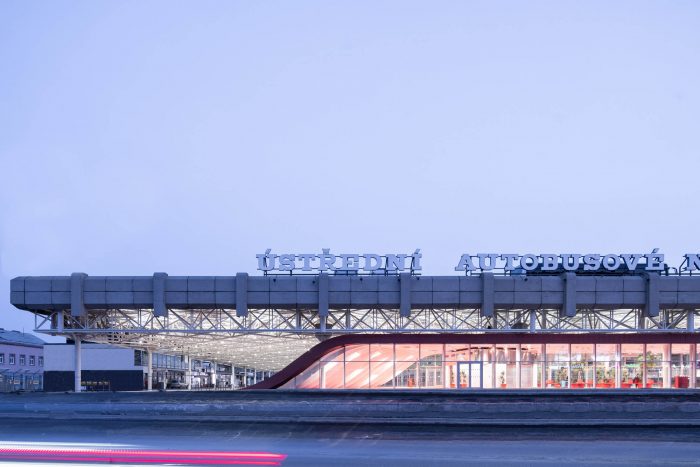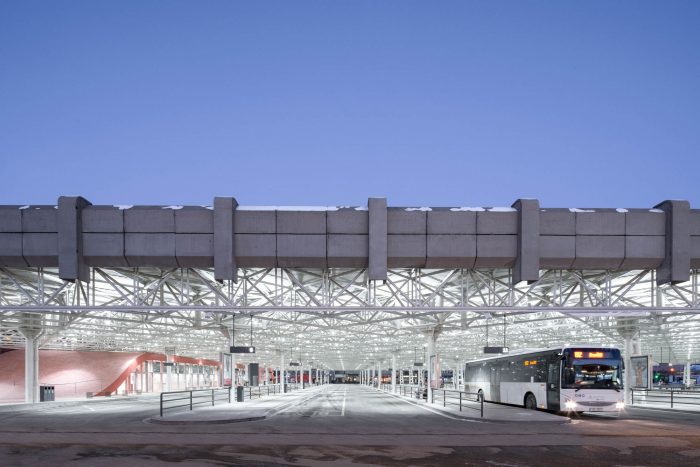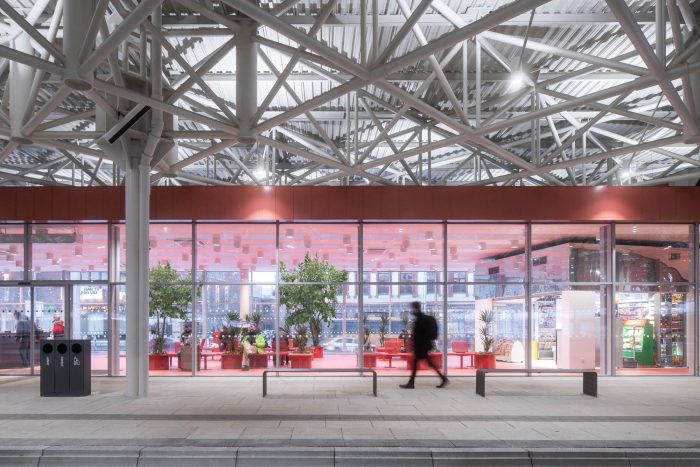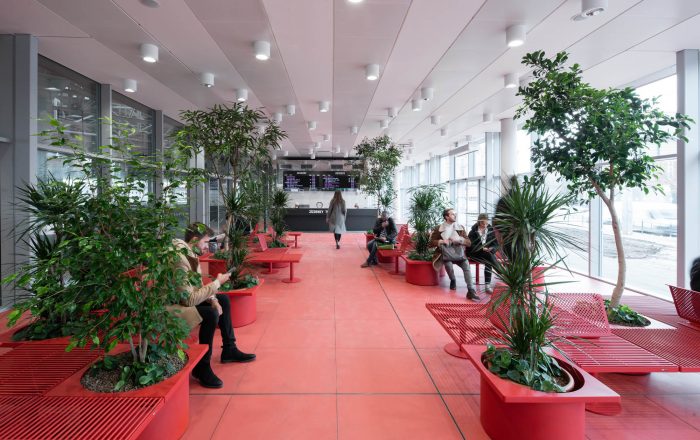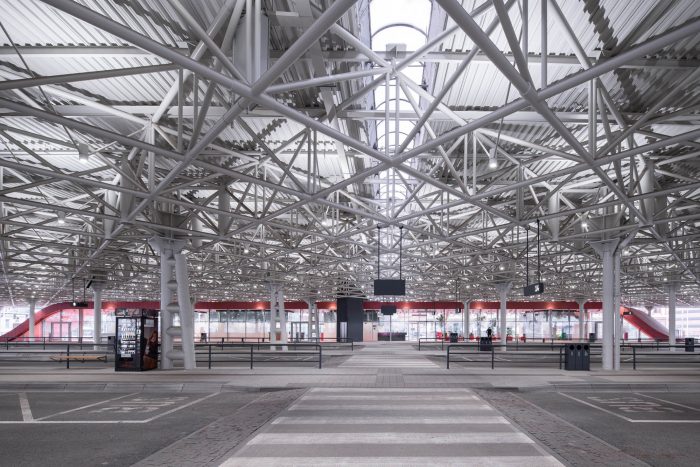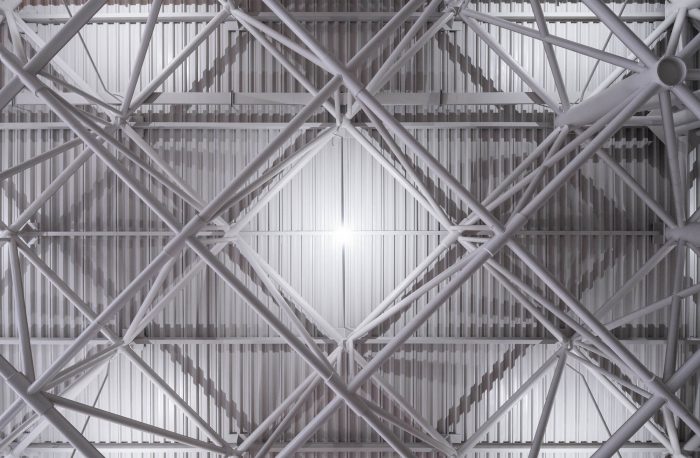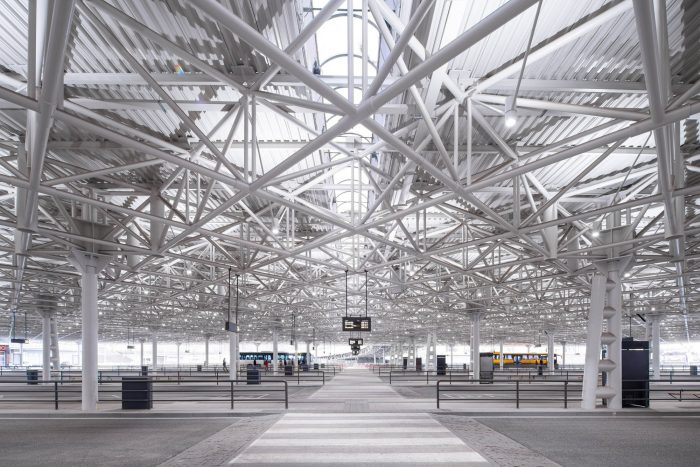在2011年自行发起的这个重新设计和修复项目中,建筑师们积极致力于保护现有的野蛮主义结构及其原有的建筑特征,体现了CHYBIK + KRISTOF对延续建筑遗产的承诺。他们强调了车站在城市和地区社会文化结构中的核心作用,解决了重新思考如何使用一个衰败的交通枢纽和公共空间的紧迫性。他们将透明度和通道作为设计的根本,将公共汽车站改造成一个适应当前社会需求的功能实体。CHYBIK + KRISTOF强调了他们项目中一贯的社会意识,肯定了建筑师作为积极社会变革的代理人的责任。
与布拉格国际知名的普拉哈酒店和Transgas建筑一样,建于1988年的布尔诺Zvonarka中央巴士站长期以来一直被认为是捷克共和国野蛮主义建筑遗产中值得注意的遗留例子之一。野蛮主义或 “béton brut”–指的是同时颂扬进步性和实验性的裸露混凝土建筑–在战后的大部分建筑中占主导地位,长期以来一直使建筑师和学者们两极分化,其中包括CHYBIK + KRISTOF。像从扎哈-哈迪德到隈研吾等知名人士一样,他们一直主张保护野蛮派建筑遗产,并引用其耐人寻味的美学和原材料品质。
Self-initiated in 2011, this redesign and restoration project saw the architects actively engage in preserving the existing Brutalist structure and its original architectural identity, reflecting CHYBIK + KRISTOF’s commitment to perpetuating architectural heritage. Stressing the station’s central role in the city and region’s sociocultural fabric, they address the urgency to rethink the use of a decaying transportation hub and public space. Placing transparency, and access, at the root of their design, they have transformed the bus terminal into a functional entity adapted to current social needs. Underlining the social awareness that consistently informs their projects, CHYBIK + KRISTOF affirm architects’ responsibility in acting as agents for positive social change.
Akin to the internationally renowned Hotel Praha and Transgas buildings in Prague, Brno’s Zvonarka Central Bus Terminal, built in 1988, has long been considered one of the notable remaining examples of the Czech Republic’s Brutalist architectural heritage. Dominating much of post-war architecture, Brutalism or “béton brut” – referring to the exposed concrete architecture that simultaneously celebrates progressiveness and experimentalism – has long polarized architects and scholars alike, among whom CHYBIK + KRISTOF. Like notable figures from Zaha Hadid to Kengo Kuma, they have consistently advocated for the preservation of Brutalist architectural heritage, citing its intriguing aesthetic and raw material qualities.
近年来,许多这样的建筑被拆除或受到威胁–其中包括现已拆除的普拉哈酒店(2014年)和Transgas(2019年)、伦敦有争议的罗宾汉花园(2017年)和美国的Burroughs Wellcome大楼(2021年),CHYBIK + KRISTOF申明他们参与保护这些建筑,将野蛮主义的Zvonarka公交车站建筑作为这种情况的一个当地案例。
Zvonarka中央巴士站设计于1984年,建于1988年,一直是该地区城际交通的主要巴士站。1989年,该建筑被私有化,只完成了第一阶段的建设,并恢复了其作为公交车站的作用。作为一个公认的野蛮主义遗产地,其高额的维护费用导致了很少的维护,促使其逐渐恶化。
2011年,CHYBIK + KRISTOF意识到该车站的衰败状况。他们渴望为这个看似无法恢复的空间提供一个积极的替代方案,于是向其私人业主提出了一个基本的重新设计方案。他们的倡议通过社交媒体引起了公众的广泛关注,促使当地私人利益相关者和公共当局之间的对话–经过长达四年的合作交流,在2015年获得了所需的资金,特别是通过该项目作为欧洲基金项目的认可。2021年,十年后,建筑师们现在揭开了修复和重新设计的交通枢纽和公共空间的面纱–一个被保留下来的布鲁托主义遗产地和重新配置的功能空间,既关注其历史,也关注不断发展的社会需求。
With many such structures demolished or threatened in recent years – among which the now-demolished Hotel Praha (2014) and Transgas (2019), the controversial Robin Hood Gardens (2017) in London, and the Burroughs Wellcome Building (2021) in the United States, CHYBIK + KRISTOF affirm their engagement for their protection, placing the Brutalist Zvonarka Bus Terminal building as a local case-in-point of such circumstances.
Designed in 1984 and built in 1988, the Zvonarka Central Bus Terminal has continuously acted as the region’s main bus station for intercity transport. In 1989, the building was privatized, with only the first phases of construction complete, and resuming its role as a bus station. Recognized as a Brutalist heritage site, its high maintenance costs led to little upkeep, driving to its gradual deterioration.
In 2011, CHYBIK + KRISTOF grew aware of the station’s decaying conditions. Eager to advance a positive alternative to a seemingly irrecoverable space, they reached out to its private owners with an elementary redesign proposal. Drawing wide public attention through social media, their initiative prompted a conversation between local private stakeholders and public authorities – and after a four-year-long collaborative exchange, the required funding was attained in 2015, notably through the project’s recognition as a European funds project. In 2021, ten years later, the architects now unveil the restored and redesigned transportation hub and public space – a preserved Brutalist heritage site and reconfigured functional space, attentive to both its history and to evolving social needs.
Zvonarka中央巴士站反映了CHYBIK + KRISTOF在构思其项目时深刻的社会意识。首先确定正在进行的社会动态,他们与不同的利益相关者–建筑师、公共实体和私人合作伙伴、当地和外部的利益相关者接触。他们采用整体的社会文化和技术方法,最终提出了一个以用户为中心的、有意识的设计–一个超越单纯的施工过程的设计。他们强调车站作为进入和离开城市的点的作用,概述了这个过渡空间的意义,因为交通枢纽日益成为城市的窗口。在构思接受用户需求的功能重新设计的同时,建筑师培养了车站作为城市社会神经的本质,设想如何将其进一步融入周围的城市结构,并在其中邀请新的社会动力。
忠实于这两项工作,CHYBIK + KRISTOF将自己定位为这个城市空间的建筑师和公民。在这样做的时候,他们考虑到现有的和设想的、公共的和私人的、功能的和体验的内在关系、细微差别和协同作用–同时强调车站作为一个交通枢纽的主要作用,每天有820多个地区、国家和国际的连接和17000名乘客通过这个交通枢纽。
The Zvonarka Central Bus Terminal mirrors CHYBIK + KRISTOF’s profound social awareness in conceiving their projects. First identifying the ongoing social dynamics, they engage with diverse stakeholders – architects, public entities and private partners, local and external. Adopting a holistic socio-cultural and technical approach, they ultimately bring forward a user-centered, conscious design – one that moves beyond the mere construction process. Stressing the station’s role as the point of entry into and departure from the city, they outline the significance of this transitional space, as transportation hubs increasingly come to act as windows onto cities. All the while conceiving a functional redesign receptive to users’ needs, the architects cultivate the station’s essence as the city’s social nerve, envisioning how to further integrate it into the surrounding urban fabric and invite new social dynamics within it.
True to these two engagements, CHYBIK + KRISTOF position themselves as both architects and citizens of this urban space. In doing so, they consider the inherent relationships, nuances and synergies between the existing and the envisioned, the public and the private, the function and the experience – all-the-while stressing the station’s primary role as a transportation hub, through which over 820 regional, national and international connections and 17,000 passengers transit each day.
透明度是他们新设计的基础。为了向其最初的建筑师拉杜兹-拉斯致敬,他们自豪地展示了车站特有的原始野蛮主义结构,将其棱角与反映车辆和乘客无缝流动的有机波浪形成对比。他们还转向了结构的透明性,拆除了墙壁,倾向于用光线来唤起人们对通道、安全和舒适的关注。按照原来的方形平面图,他们将主厅重新配置为一个没有墙壁的开放结构。一个两面的屋顶,内部空间容纳了各个巴士站,而外部区域作为巴士的停车空间。建筑师急于将终点站向城市开放,拆除了20世纪90年代增加的临时结构,并在街道上建立了一个通往车站的第二个入口。他们在破旧的主结构上添加了新的灯具,并将其重新刷成白色,同时引入了一个新的信息办公室、售票和候车区、站台以及一个残疾人可以使用的导向系统。通过这个设计,CHYBIK + KRISTOF将该建筑改造成一个动态的、功能性的和内在的社会枢纽,引导当地人和乘客不受限制地流动。
Transparency is at the root of their new design. Paying homage to its original architect Radúz Russ, they proudly expose the station’s characteristically raw Brutalist structure, contrasting its angularity with an organic wave that mirrors the seamless flow of vehicles and passengers. They also turn to structural transparency, removing walls and favoring light as evocative of access, safety and comfort. Following the original square floorplan, they reconfigure the main hall as an open structure devoid of walls. A two-sided roof, the inner space houses the individual bus stops while the outer area serves as a parking space for buses. Eager to open up the terminal onto the city, the architects remove the temporary structures added in the 1990s and erect a second entry to the station at street level. Adding new light fixtures onto the main worn-down structure, which they repaint in white, they introduce a new information office, ticketing and waiting areas, platforms, and an orientation system accessible to the disabled. Through this design, CHYBIK + KRISTOF transform the building into a dynamic, functional and intrinsically social hub, channeling an unrestricted flow of locals and passengers alike.
除了Zvonarka中央巴士站及其周边地区的重新设计将在未来几年逐步展开外,CHYBIK + KRISTOF还在布尔诺启动了几个重新开发项目。其中,孟德尔广场和孟德尔温室项目将于2022年完工,在孟德尔诞辰200周年之际向这位声名狼藉的科学家和现代遗传学之父致敬,反过来,将重新审视现有的空间,一个独特的遗产地,作为一个开放的交通枢纽–扎根于布尔诺悠久的历史,并对其不断变化的社会动态作出反应。
In addition to the redesign of the Zvonarka Central Bus Terminal and of its surrounding areas to unfold gradually in the coming years, CHYBIK + KRISTOF have initiated several redevelopment projects in Brno. Among these, the Mendel Square and Mendel Greenhouse projects, to be completed in 2022 in homage to the notorious scientist and father of modern genetics on the 200th anniversary of his birth, will, in turn, revisit the existing space, a distinct heritage site, as an open transportation hub – rooted in Brno’s longstanding history and responsive to its evolving social dynamics.
Architects: CHYBIK + KRISTOF
Year: 2021
Photographs: Alex Shoots Buildings
City:Brno-střed
Country:Czech Republic

